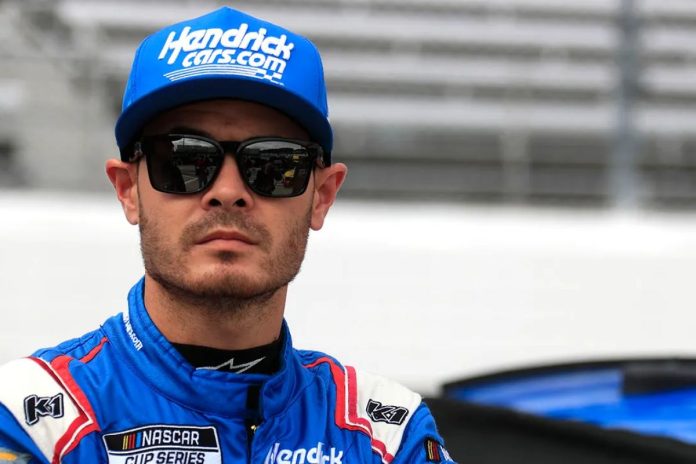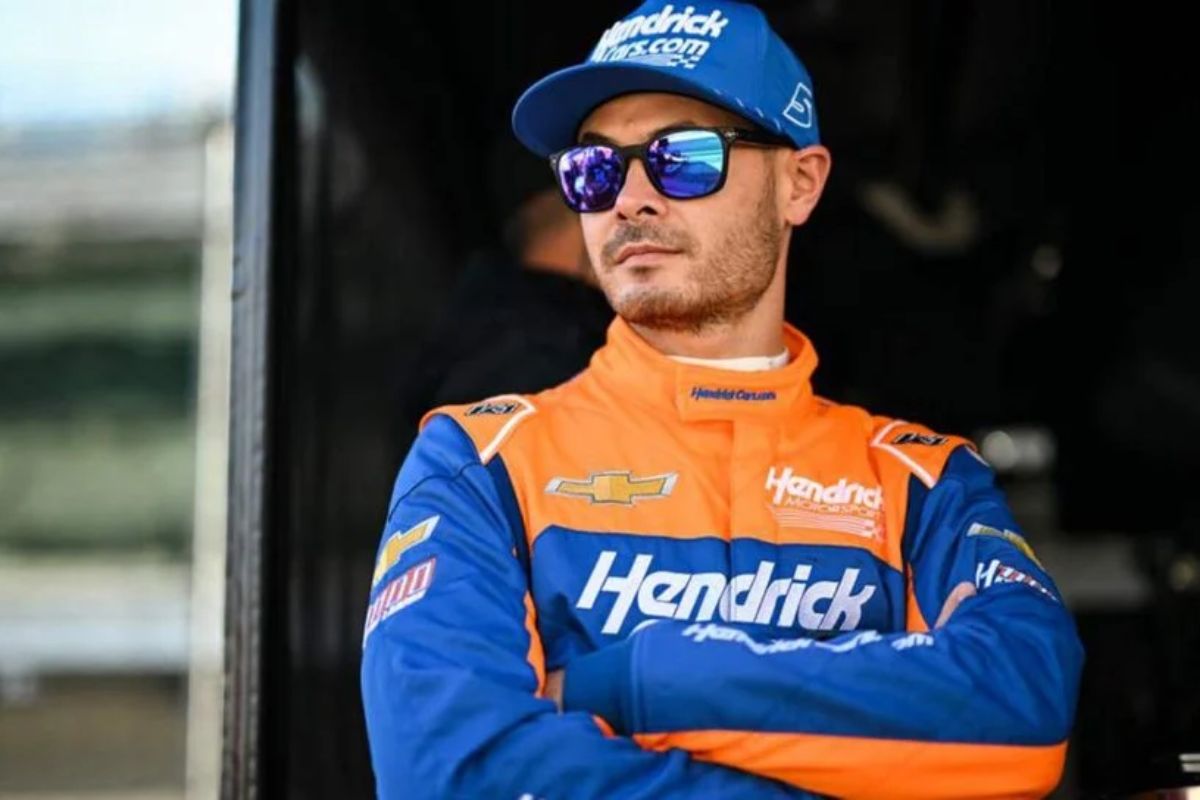Kyle Larson on Watkins Glen’s Curbs: In motorsports, minor alterations to a track can lead to significant strategic shifts among teams and drivers. Kyle Larson’s recent remarks on the new curbing at Watkins Glen International exemplify this dynamic, highlighting a growing concern among drivers regarding its implications for race strategy and vehicle durability. While Larson acknowledges some benefits to the changes, including potential safety improvements, the broader implications for tire wear and brake effectiveness remain contentious topics.
Key Takeaways
- Larson expressed views about new curbing at Watkins Glen affecting braking points and vehicle stability.
- Emphasized need for drivers to carefully evaluate curbing impact during practice sessions.
- Larson also noted potential for curbing to influence suspension setups, requiring adjustments.
- Despite concerns, he defended the curbing, citing benefits in precision and safety.
Kyle Larson Addresses Recent Change at Watkins Glen International
Addressing the recent modifications at Watkins Glen International, Kyle Larson expressed his reservations about the newly installed curbing at the track’s bus stop chicane, emphasizing the potential impact on race dynamics and driver safety. Larson, a seasoned driver with a keen understanding of how even minor alterations can affect a race car’s behavior, highlighted concerns that the curbing could alter braking points and vehicle stability through the chicane.
From a technical perspective, the introduction of new curbing at such a critical point of Watkins Glen can greatly influence tire wear and suspension setups. Drivers might find themselves needing to adjust their approach angles, potentially compromising their exit speeds and overall lap times. Additionally, the physical nature of curbing can lead to increased mechanical stress on vehicles, particularly impacting components like tie rods and suspension struts.
Drivers React to Changes at Watkins Glen
Frequently, drivers like Xfinity Series regular Parker Kligerman have voiced their dissatisfaction with the newly installed curbing at Watkins Glen, citing concerns over its impact on race performance and safety. The introduction of these curbs, while intended to demarcate the track boundaries clearly, has sparked a significant debate among competitors, who worry about the potential repercussions on vehicle control and the general integrity of racing movements.
Oh no… @WGI what have you done?! https://t.co/VJmbpCuKgL
— Parker Kligerman (@pkligerman) April 25, 2024
Analyzing the situation, the discontent stems from a fear that these curbs could lead to increased tire wear or damage when vehicles are driven aggressively over them. Drivers argue that, in the heat of the race, maintaining a prime line might necessitate close contact with these boundaries, potentially leading to unforeseen mechanical failures or loss of control. The precision with which these curbs have been installed requires a recalibration of driving strategies, demanding higher levels of precision and caution.
Kyle Larson Defends New Curbing
While some drivers have expressed reservations about the new curbing at Watkins Glen, Kyle Larson has presented a counterargument, emphasizing its benefits in aiding maneuvering through the chicane in the context of the Next Gen car’s reduced loads. Larson’s perspective is bolstered by sensor data, which he refers to when discussing the impact of these changes on driving dynamics.
“My mouth piece data from last year through the bus stop. Something needed to be done. What was there before was not safe for the brain. Hopefully this is better.”-Kyle Larson
My mouth piece data from last year through the bus stop. Something needed to be done. What was there before was not safe for the brain. Hopefully this is better. pic.twitter.com/AjpN7unIsb
— Kyle Larson (@KyleLarsonRacin) April 25, 2024
- Adaptation to Next Gen Cars: The Next Gen cars have different load characteristics compared to their predecessors. According to Larson, the new curbing complements these changes, potentially reducing tire wear and improving lap times.
- Enhanced Safety: Contrary to concerns, Larson suggests that the curbing could lead to increased safety. The structure and placement might help in preventing cars from clipping the chicane too aggressively, which can lead to accidents.
- Data Verification: The use of sensor data from the driver’s mouthpiece provides objective feedback on the physical impact of the curbing on car handling and driver comfort.
Kyle Larson’s Throwback Livery Honoring Terry Labonte
In a nostalgic nod to racing history, Kyle Larson will commemorate former NASCAR Cup Series champion Terry Labonte by featuring the iconic Kellogg’s Corn Flakes livery on his No. 5 Chevrolet Camaro ZL1 during the upcoming throwback weekend at Darlington Raceway.
Kyle Larson surprises Terry Labonte with his throwback paint scheme for Darlington. #NASCAR #RaceHub @TeamHendrick | @Hendrick5Team pic.twitter.com/mb8XjJgufV
— FOX: NASCAR (@NASCARONFOX) April 25, 2024
The decision to adopt this particular design is steeped in a rich narrative. Labonte, often dubbed ‘The Iceman’ for his cool demeanor on the track, drove the Kellogg’s Corn Flakes car to numerous victories, making it one of the most recognizable liveries in the sport’s history.
NASCAR Goes Live from Dover Motor Speedway
As NASCAR prepares for the 2024 Wurth 400, Dover Motor Speedway becomes a focal point for fans and teams excited to witness the unfolding of this significant race in the series. Known as the ‘Monster Mile,’ this track presents unique challenges that not only test the mettle of racers but also highlight the strategic subtleties of NASCAR racing.
Dover Motor Speedway, with its high-banked, one-mile concrete oval, demands a blend of aggression and precision from drivers. The track’s surface, characterized by its ability to wear tires aggressively, plays a vital role in race strategy. Teams must carefully plan pit stops and tire changes to avoid losing precious time on the track. The track’s narrow pit road further complicates these strategies, demanding flawless execution under stress.
- Tire Management: The concrete surface causes rapid tire wear, pushing teams to optimize their tire strategy carefully.
- Aerodynamic Setup: Cars need to be set up with a balance between downforce for corner stability and reduced drag for speed on the straights.
- Driver Skill: Mastery of the ‘Monster Mile’ requires drivers to exhibit precise throttle control and braking to navigate its tight turns without succumbing to the wall.
- Pit Crew Efficiency: The narrow pit road at Dover tests the efficiency and speed of pit crews, often making or breaking a race during critical stops.
News in Brief: Kyle Larson on Watkins Glen’s Curbs
The modifications to the curbing at Watkins Glen International present many complex challenges and benefits, necessitating a reassessment of driving strategies.
While drivers like Kyle Larson acknowledge the precision benefits and potential safety enhancements of the new curbing, concerns regarding vehicle stability, tire wear, and mechanical stress persist.
These factors highlight the importance of rigorous evaluation and adaptation during practice sessions to optimize performance and guarantee safety in competitive racing environments.
Our Reader’s Queries
Q. Why is Kyle Larson starting last at Talladega?
A. Larson faces an uphill battle as he’s relegated to the back of the pack, positioned at No. 38 on the starting grid. This setback comes after he was unable to participate in Saturday’s qualifying session, resulting in a green flag pass-through penalty. Now, with his starting position determined, Larson will need to mount a formidable charge through the field to contend for a strong finish.
Q. Why is Larson a lap down?
A. NASCAR’s verdict dealt Larson a blow as he was deemed ineligible to complete a qualifying lap. The ruling stemmed from unapproved adjustments made to the roof rail on the No. 5 Chevrolet Camaro ZL1, a discrepancy detected as the car was being pushed to the grid for Busch Light Qualifying on Saturday morning. This unexpected turn of events leaves Larson sidelined from the qualifying session and facing hurdles ahead on race day.
Q. How old was Kyle Larson when he started racing?
A. Born on July 31, 1992, amidst the racing fervor of Elk Grove, California, Larson’s journey into the world of motorsport commenced at an astonishingly early age. Just a week after his birth, he made his inaugural appearance at a race track, accompanied by his parents, igniting a passion that would define his future. By the age of 7, Larson was already behind the wheel, navigating the tight turns of outlaw karts in the picturesque landscapes of Northern California, laying the foundation for what would become a storied racing career.
ALSO READ: Kyle Larson Honors Terry Labonte: Epic Darlington Tribute





